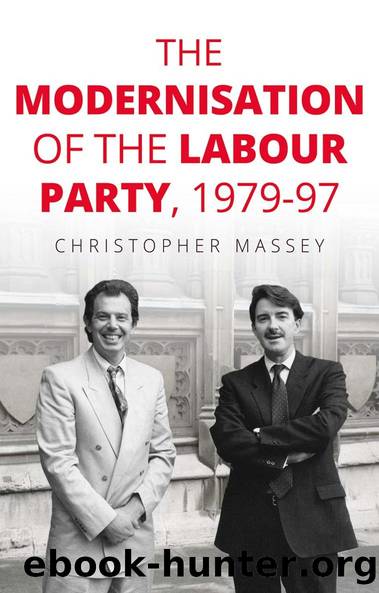The modernisation of the Labour Party, 1979â97 by Christopher Massey

Author:Christopher Massey [Massey, Christopher]
Language: eng
Format: epub
Tags: Political Science, Comparative Politics, Political Process, Political Parties, History, Europe, Great Britain, 20th Century, General
ISBN: 9781526144447
Google: cy_vDwAAQBAJ
Publisher: Manchester University Press
Published: 2020-07-06T16:05:54+00:00
Levy-Plus
With the consultation on the Interim Report open until 10 July 1993, the Review Group was inactive until this deadline. As the Interim Report offered little in the way of a conclusion and instead opened up a variety of options, there was no opportunity for consensus around the document. Moreover, the trade union conference season had widened the chasm which now looked unlikely to be bridged. Thus, in the period between March and July 1993, key union figures such as Bickerstaffe, Sawyer, Anne Gibson and Hilary Armstrong, alongside politicians such as Prescott, worked behind the scenes to try to find a compromise to avoid an embarrassing defeat for Smith at the 1993 Labour Conference in October. This compromise took the form of âlevy-plusâ, which was an extension of the discarded registered supportersâ scheme. Rather than trade union members who paid the political levy having to be signed up as âregistered supportersâ by their union, levy-plus required such members to pay a nominal fee in order to participate in future internal elections. The significance of levy-plus was that it gave union leaders sympathetic to Smith an opportunity to be flexible with their union bloc votes, with many mandated to vote against a registered supportersâ scheme but having no mandate on levy-plus.92
Levy-plus was, in some ways, a marked improvement on the registered supportersâ scheme. Although at this stage some unions, such as NUPE, had centralised computer systems with the details of all their levy-paying members, other unions only held uncatalogued, written records. As such, implementing a registered supportersâ scheme, would have required the details of all union members paying the political levy and clearly would have been a logistical nightmare for unions without computer-based records, hence the large costs reported to Whitty in November 1992. However, levy-plus would require those union members paying the political levy to âtop upâ their union contributions in order to become full members of the Labour Party. This would allow the Labour Party to have a central record of all members, and was good value for union members. In 1993 the Labour Partyâs individual membership fee was £18, whereas âlevy-plusâ, at this stage, proposed a total payment of around £5 a year, comprising of the levy and the membership fee.93
The actual authorship of the levy-plus idea is unclear. Gordon Brown had mooted a very similar idea in 1987 in a Tribune pamphlet, Prescott had used the term in his deputy leadership campaign of 1988, and Phil Wilson, one of Blairâs staff, had included the phrase in a report to Blair in 1992.94 In 1993, however, two figures have principally been credited with revisiting the idea of levy-plus: Prescott and Sawyer. Mark Stuart, Smithâs biographer, sees Sawyerâs role as critical, stating that he: âprovided a way out of the stalemateâ by introducing the idea of the levy-plus scheme. Minkin also credits Sawyerâs âtactical skillsâ in assisting Smith on this issue.95 Furthermore, Fryer and Williams, state that Sawyer proposed âa scheme under which levy paying trade union members could âtop upâ their contributionsâ.
Download
This site does not store any files on its server. We only index and link to content provided by other sites. Please contact the content providers to delete copyright contents if any and email us, we'll remove relevant links or contents immediately.
Room 212 by Kate Stewart(4143)
The Crown by Robert Lacey(4135)
Endurance: Shackleton's Incredible Voyage by Alfred Lansing(3884)
The Iron Duke by The Iron Duke(3671)
The Rape of Nanking by Iris Chang(3559)
Killing England by Bill O'Reilly(3484)
Joan of Arc by Mary Gordon(3288)
Say Nothing by Patrick Radden Keefe(3102)
I'll Give You the Sun by Jandy Nelson(2864)
Shadow of Night by Deborah Harkness(2774)
Hitler's Monsters by Eric Kurlander(2757)
Margaret Thatcher: The Autobiography by Thatcher Margaret(2706)
Mary, Queen of Scots, and the Murder of Lord Darnley by Alison Weir(2695)
Darkest Hour by Anthony McCarten(2671)
Blood and Sand by Alex Von Tunzelmann(2629)
Red Famine: Stalin's War on Ukraine by Anne Applebaum(2490)
Eleanor & Park by Rainbow Rowell(2424)
The One Memory of Flora Banks by Emily Barr(2372)
Book of Life by Deborah Harkness(2303)
